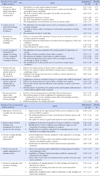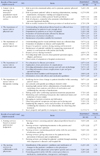Abstract
Methods
The two steps in developing the items were items related to what would be desirable policies and items on how the policies should be developed for patient safety regarding nurse workforce. A literature review was done and suggestions from experts through two rounds using the Delphi technique were outlined. The fifteen experts who participated in this study were six representatives of service consumers and nine representatives of service providers (four medical doctors and fives nurses).
Figures and Tables
References
1. Yoo SJ, Choi KS, Kim HY. A study of improvement plan for workforce standards law system. Korea Health Industry Development Institute;2013. p. 27–28.
2. Lee SY, Kim HJ. Manpower structure improvement plan for improving quality of medical service. Nursing resources management. Research Community Health and Suggesting Alternatives;2008.
3. Aiken LH, Clarke SP, Cheung RB, Sloane DM, Silber JH. Educational levels of hospital nurses and surgical patient mortality. JAMA. 2003; 290(12):1617–1623. http://dx.doi.org/10.1001/jama.290.12.1617.
4. Aiken LH, Sloane DM, Cimiotti JP, Clarke SP, Flynn L, Seago JA, et al. Implications of the California nurse staffing mandate for other states. Health Serv Res. 2010; 45(4):904–921. http://dx.doi.org/10.1111/j.1475-6773.2010.01114.x.
5. Cho SH, Ketefian S, Barkauskas VH, Smith DG. The effects of nurse staffing on adverse events, morbidity, mortality and medical costs. Nurs Res. 2003; 52(2):71–79.
6. Estabrooks CA, Midodzi WK, Cummings GG, Ricker KL, Giovannetti P. The impact of hospital nursing characteristics on 30-day mortality. Nurs Res. 2005; 54(2):74–84.
7. Mark BA, Harless DW, McCue M, Xu Y. A longitudinal examination of hospital registered nurse staffing and quality of care. Health Serv Res. 2004; 39(2):279–300. http://dx.doi.org/10.1111/j.1475-6773.2004.00228.x.
8. McGillis Hall L, Doran D, Pink GH. Nurse staffing models, nursing hours, and patient safety outcomes. J Nurs Adm. 2004; 34(1):41–45.
9. Huston CJ. Outcomes measurement in health care: New imperatives for professional nursing practice. Nurs Case Manag. 1999; 4(4):188–195.
10. Park SH. Analysis of nursing outcome and direct nursing care activity related to nurse-to-patient ratio [dissertation]. Seoul: Korea University;2001.
11. Kim KK. The present meaning of nursing practice in Korea. J Law Polit Res. 2007; 7(1):95–113.
12. Kim SY. Suffering from lack of nurses. Dailymedi. 2011. 10. 27. Sect. Nursing.
13. Park ET. Lack of medical resources in spite of increasing beds in hospital...quite contrary to OECD'. Medipana. 2013. 06. 04.
14. Kim YJ. Nurses' aides can substitute the nurse?...Patients feel nervous. Hankyoreh News. 2013. 07. 02. Sect. Health.
15. Cho SH, Hwang JH, Kim J. Nurse staffing and patient mortality in intensive care units. Nurs Res. 2008; 57(5):322–330. http://dx.doi.org/10.1097/01.NNR.0000313498.17777.7.
16. Park BH, Jeon KJ, Kim YM. A Survey on the Nurse Staffing Level and Patient Outcome. J Korean Acad Nurs Adm. 2003; 9(4):559–569.
17. Kim YM, Cho SH, Jeon KJ, Shin SA, Kim JY. Effects of hospital nurse staffing on in-hospital mortality, pneumonia, sepsis, and urinary tract infection in surgical patients. J Korean Acad Nurs. 2012; 42(5):719–729. http://dx.doi.org/10.4040/jkan.2012.42.5.719.
18. Lee H, Ko YK, Kim MW. The Effects of Medical Staffing Level on Length of Stay. J Korean Acad Nurs Adm. 2011; 17(3):327–335.
19. Shin & Partners. Medical treatment act information [Internet]. Seoul: Shin & Partners;cited 2014 March 1. Available from: http://www.shinlaw.net.
20. Supreme Court of Korea. Electronic Case Filing System [Internet]. Seoul: Supreme Court of Korea;2014. cited 2014 March 1. Available from: http://www.scourt.go.kr/portal/information/events/search/search.jsp.




 PDF
PDF ePub
ePub Citation
Citation Print
Print





 XML Download
XML Download